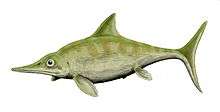Guizhouichthyosaurus
| Guizhouichthyosaurus Temporal range: Middle Triassic, 235–221 Ma | |
|---|---|
| Scientific classification | |
| Kingdom: | Animalia |
| Phylum: | Chordata |
| Class: | Reptilia |
| Order: | †Ichthyosauria |
| Clade: | †Euichthyosauria |
| Genus: | †Guizhouichthyosaurus Cao & Luo, 2000 |
| Binomial name | |
| Guizhouichthyosaurus tangae Cao & Luo, 2000 (type) | |
| Synonyms | |
| |
Guizhouichthyosaurus ("Guizhou Fish Lizard") is an extinct genus of Ichthyosaur which existed during the lower Carnian stage of the Late Triassic in southwest China. The genus contains the single species Guizhouichthyosaurus tangae.[1] It had been referred to the genus Shastasaurus in the past, but later study showed that it is likely distinct, since it lacks the characteristically short snout of that genus. Originally named as a species of Cymbospondylus (Cymbospondylus asiaticus) in 2002, and again in 2003 with Panjiangsaurus (Panjiangsaurus epicharis) before finally being placed within its own genus.[2] Size estimates based on the preserved collection of 86 presacral vertebrae and 110 caudal vertebrae brings its total length to 10 metres (33 ft).
Appearance
Following the Permian-Triassic extinction event (also colloquially known as The Great Dying), the decline and disappearance of eugeneodonts and giant nautiloids left an environmental niche empty that many marine reptiles began to fill. Guizhouichthyosaurus was one of the largest marine vertebrates of the time, whose only predators composed of large macro-predatory Ichthyosaurs (that of which preferred to hunt smaller ichthyosaurs). The rise of the shelled cephalopods (ammonites that survived the Permian-Triassic extinction event, along with the appearance of belemnites) gave ichthyosaurs an abundant food supply with little competition.Guizhouichthyosaurus and other ichthyosaurs began to adapt to hunting these cephalopods through larger eyes, and thick bodies, to handle the pressures of diving deep to hunt for their prey.
Paleobiology
Unlike other Triassic icthyosaurs, which were small fast-moving pursuit predators, the Guizhouichthyosaurus had a body build and feeding strategy similar to Shastasaurus. Guizhouichthyosaurus is a very large suction-feeder, gaining assistance in hunting invertebrates, shoft-shelled cephalopods and fish with its narrowed snout and an entireless toothless mouth, as teeth were no longer necessary in catching prey. Guizhouichthyosaurus inhabited an ecological niche similar to modern-day humpback whales, their caudal fins being reduced and its head remaining small in comparison to its body.[3]
Disappearance
Near the end of the Triassic deadly marine biocalcification began to occur, along with oceanic acidification, sea-level fluctuations and the Central Atlantic Magmatic Province(CAMP) releasing carbon dioxide, sulfur dioxide and aerosols. These environmental catastrophes caused the extinction of the conodonts and 34% of other marine genera to disappear.[4] With the amount of pressure upon the Guizhouichthyosaurus food supply, and the amount of competition it had with other larger ichthyosaurs at the time, it became less and less common reaching towards the Jurassic, and after the Triassic-Jurassic extinction event it became extinct. Other ichthyosaurs however adapted to its lifestyle, and many larger species emulated its body shape and hunting style.
See also
References
- ↑ Cranial Osteology of Guizhouichthyosaurus tangae (Reptilia: Ichthyosauria) From the Upper Triassic of China (2006). By Michael W. Maisch, Xin-Ru Pan, Zuo-Yu Sun, Tao Cai, Da-Peng Zhang, Jia-Lin Xie.
- ↑ Sander, P.M., Chen X., Cheng L. and Wang X. (2011). "Short-Snouted Toothless Ichthyosaur from China Suggests Late Triassic Diversification of Suction Feeding Ichthyosaurs." PLoS ONE 6(5): e19480. doi:10.1371/journal.pone.0019480 PMID 21625429
- ↑ http://www.plosone.org/article/info%3Adoi%2F10.1371%2Fjournal.pone.0019480 "Short-Snouted Toothless Ichthyosaur from China Suggests Late Triassic Diversification of Suction Feeding" Retrieved September 9, 2014
- ↑ Graham Ryder; David E. Fastovsky; Stefan Gartner (1996). The Cretaceous-Tertiary Event and Other Catastrophes in Earth History. Geological Society of America. p. 19. ISBN 9780813723075.

